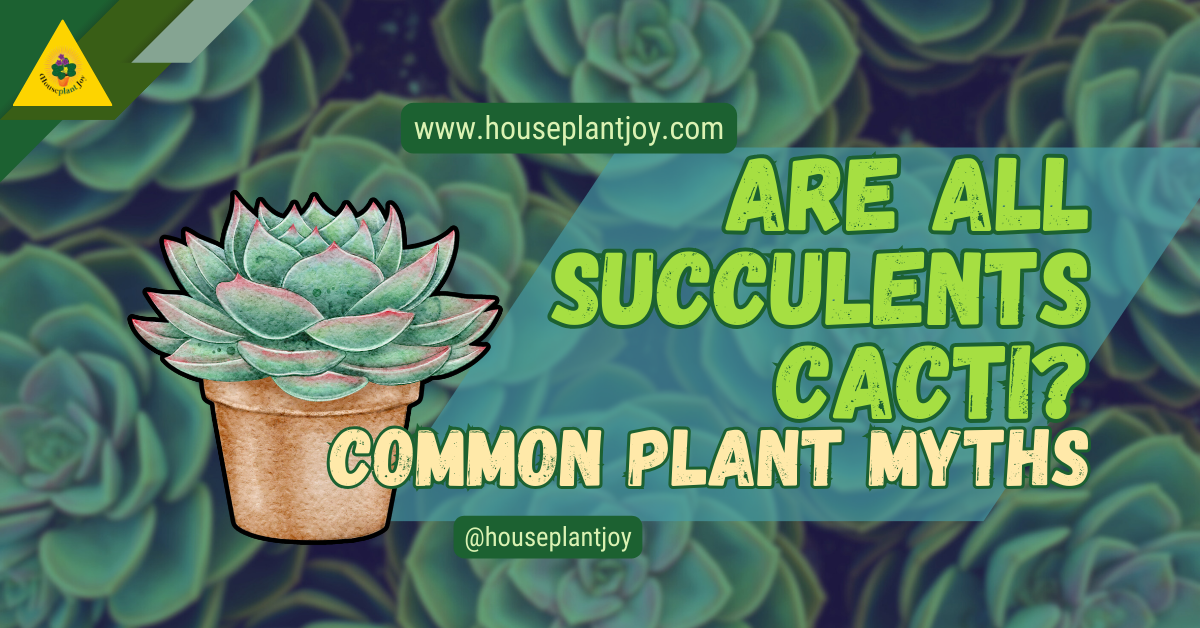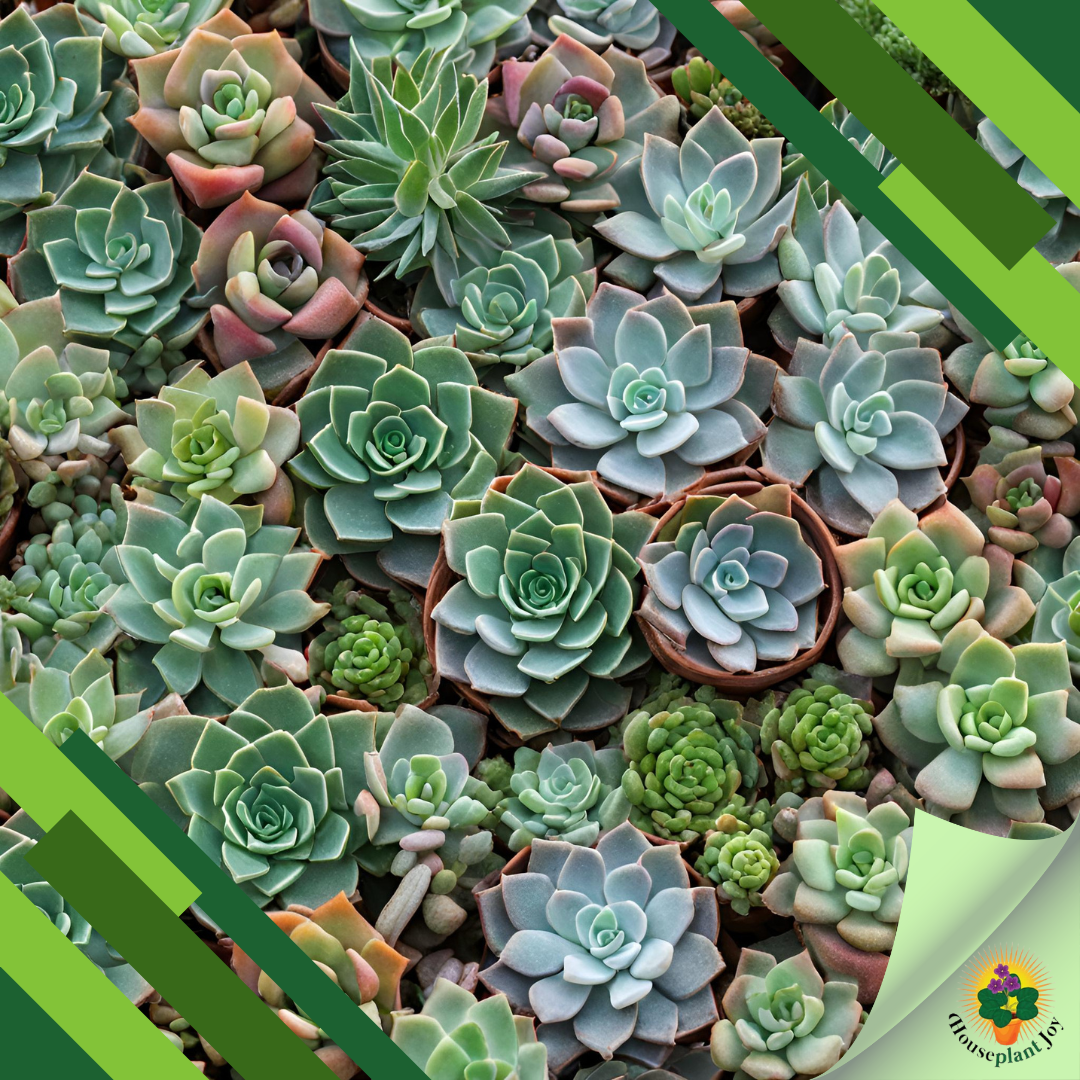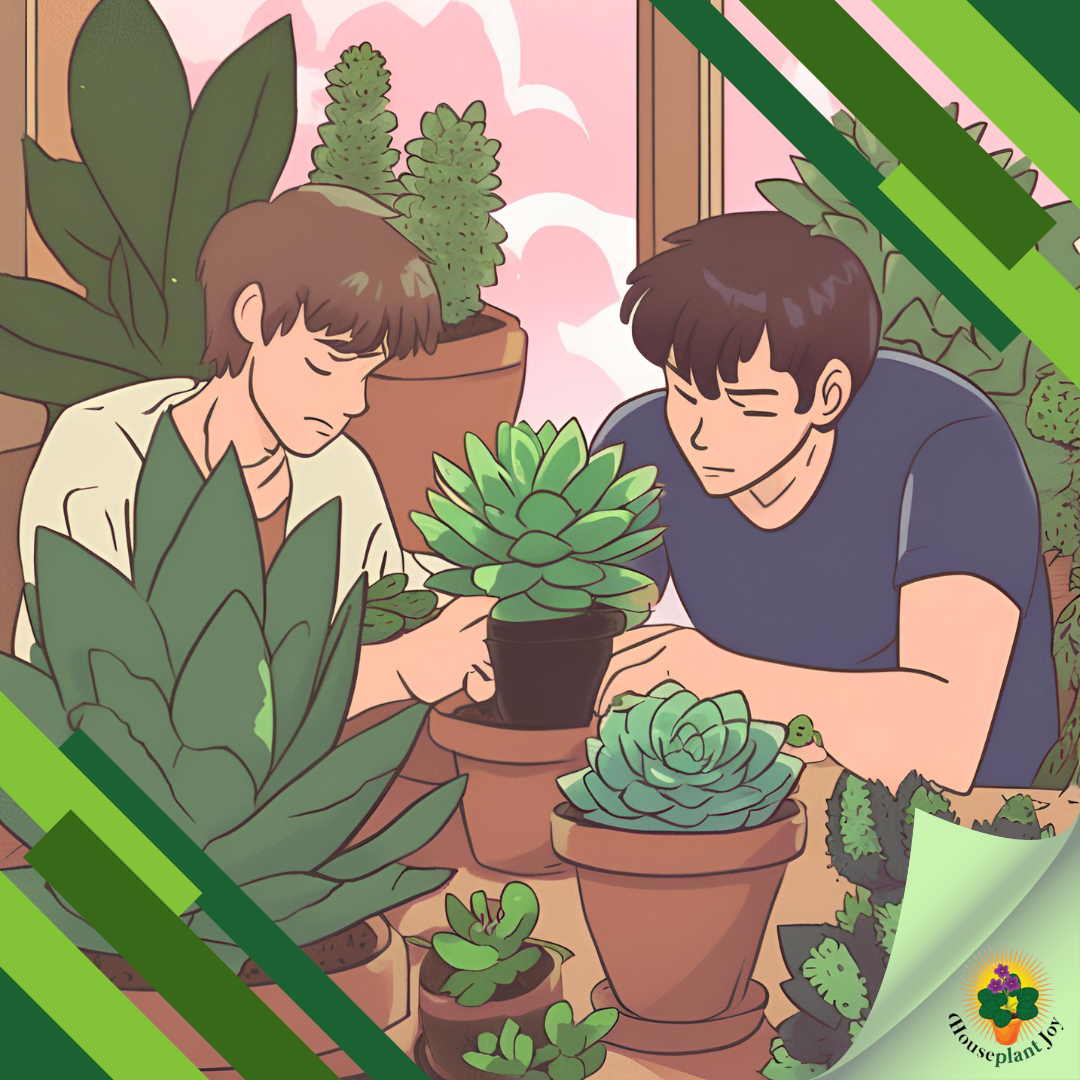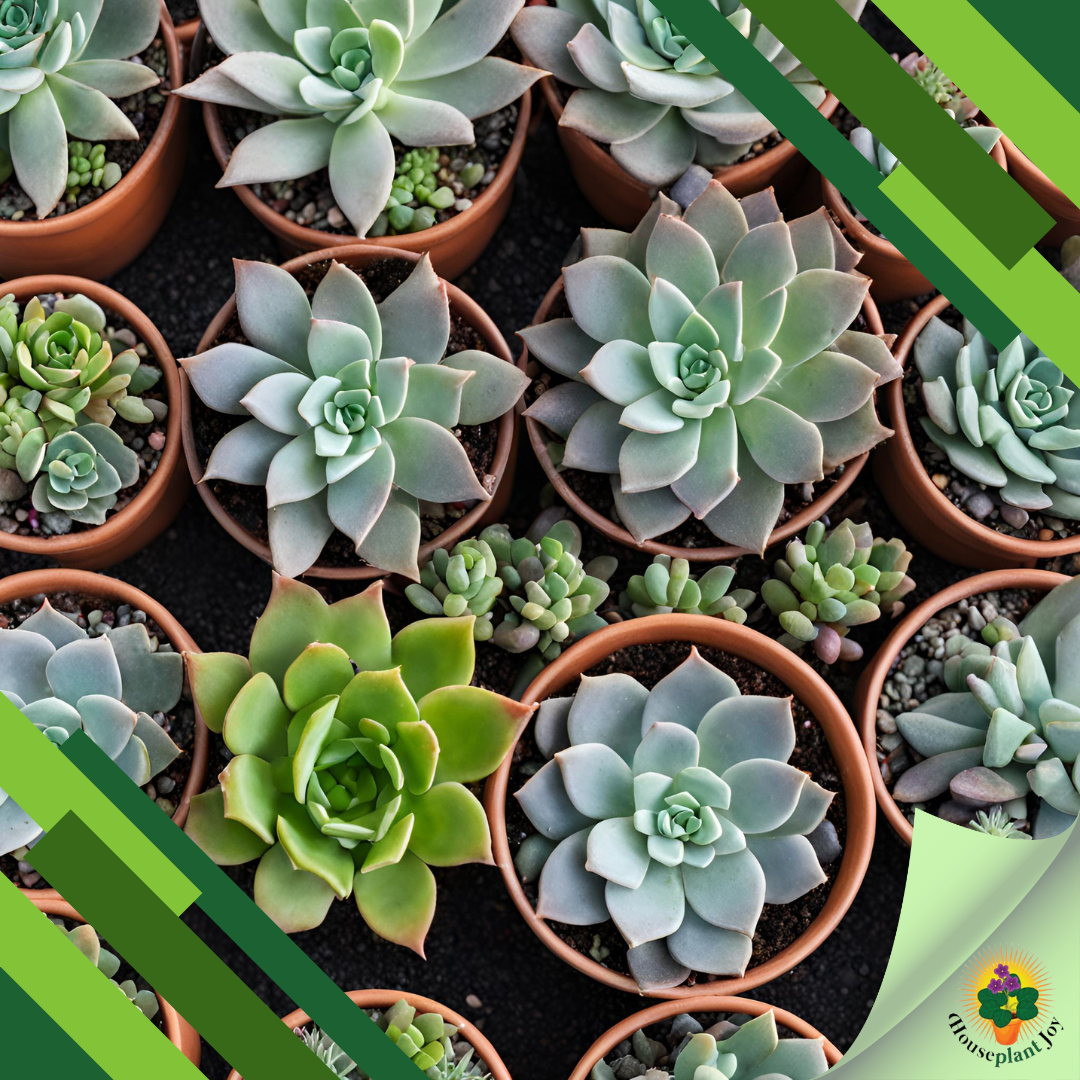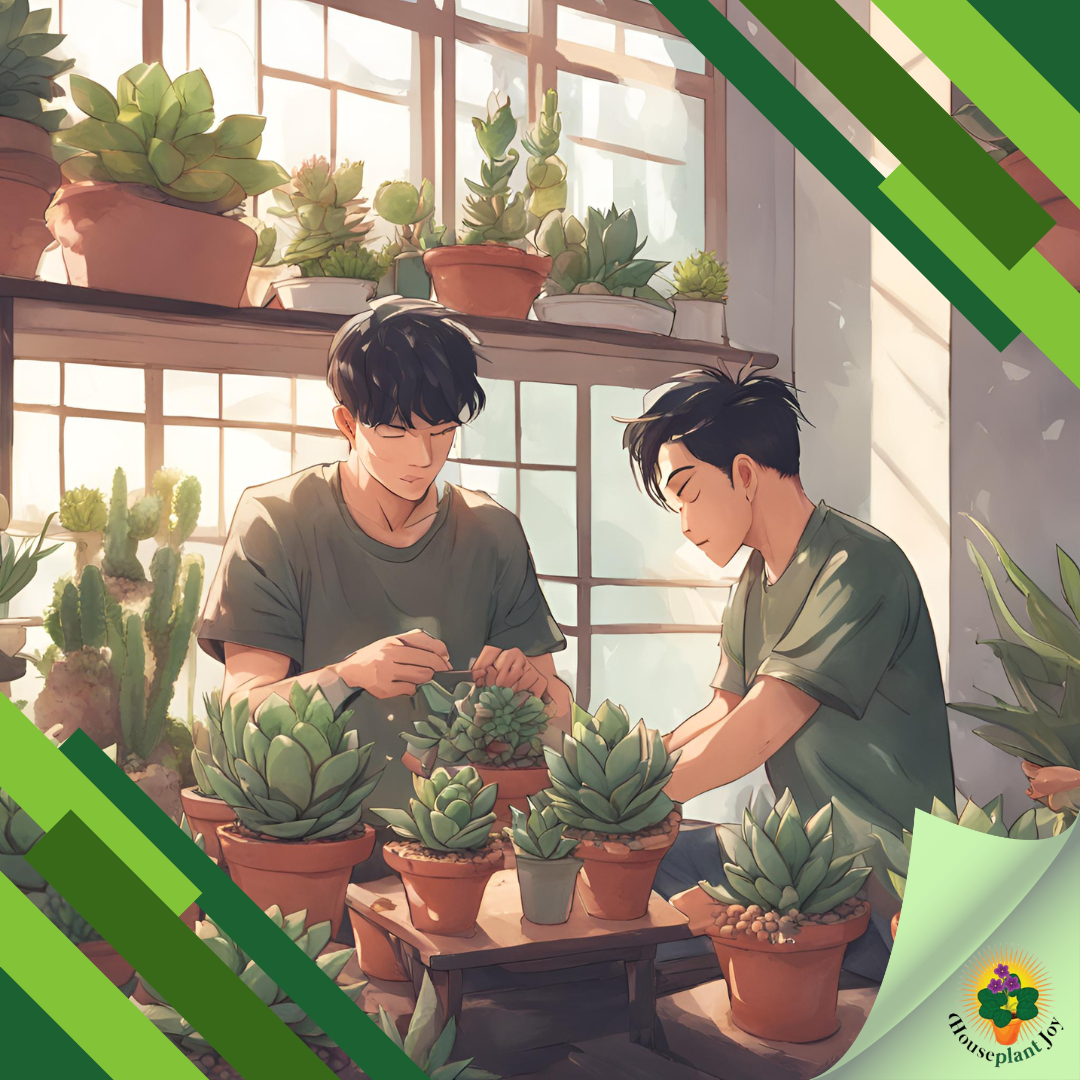HousePlantJoy is supported by our audience. When you purchase through one of our links, we may earn a small affiliate commission. As an Amazon Associate I earn from qualifying purchases. Your cost is not affected.
==================
Are all succulents cacti? That’s a question we hear a lot! While both these plant groups are popular for their resilience and interesting shapes, there’s actually a surprising difference between them. Let’s dive into the world of succulents and cacti to uncover their secrets and discover the perfect prickly (or perhaps plump!) addition to your home or garden.
Are All Succulents Cacti? Common Plant Myths
When gardening or decorating with houseplants, one might encounter a diverse array of succulents, including cacti.
To clarify, while all cacti are succulents, not all succulents are cacti.
Succulents are a broad category of plants that store water in their leaves, stems, or roots, while cacti represent a specific subgroup within the succulents that are characterized by their distinctive areoles from which spines, branches, or flowers may grow.
Understanding the differences between cacti and other succulents involves examining their physical attributes and growing requirements.
Cacti typically have thick, fleshy parts adapted to store water, making them well-suited for arid environments.
Conversely, other succulents might have different adaptations, like crassulas with their thick leaves or echeverias with their rosette shapes.
Care for these plants varies: cacti generally require less frequent watering compared to other succulents, which can differ greatly in their moisture needs and light requirements.
Key Takeaways
Characteristics of Succulents
Leaf Structure: Succulents typically have thick, fleshy leaves that are adept at storing water.
These leaves can take various forms, ranging from broad and flat to rounded and tubular, each specifically adapted to minimize water loss.
Water Storage: A key trait of succulents is their capacity to store water in specialized tissues, a feature that is especially beneficial in environments with infrequent rainfall.
This allows them to sustain periods of drought more effectively than other plants.
Diversity of Succulent Species
Variety: The succulent family comprises a wide array of species, each with unique adaptations to their environment. They can vary greatly in size, color, and shape.
- Small Groundcovers: Some succulents, like the Stonecrop, remain low to the ground and spread horizontally.
- Tower-Like Structures: Others, such as the Aloe, grow tall, with leaves that extend from a central point.
Habitat Adaptation: While many succulents are synonymous with hot, desert regions, an array are found in other environments. From sea cliffs to alpine regions, succulents have adapted to a multitude of ecological niches.
Unique Features of Cacti
Cacti are primarily identifiable by their areoles, which are specialized structures that look like cushion-like mounds on the stem of the plant.
It is from these areoles that spines, flowers, and new branches grow. This trait is exclusive to cacti within the plant kingdom.
Unlike most succulents, cacti do not have conventional leaves; instead, the leaves have transformed into spines which minimize water loss and can offer protection from herbivores.
Furthermore, cacti have a special ability to photosynthesize using a specialized mechanism known as Crassulacean Acid Metabolism (CAM).
This efficient method allows them to absorb CO2 at night when the temperature is cooler and the risk of water evaporation is lower, making them well-adapted to survive in harsh, dry conditions.
Cactus Family Overview
Cacti belong to the family Cactaceae, which comprises about 127 genera with over 1750 known species.
This family is varied, including members ranging from the towering saguaros to the diminutive peyote.
Though they are often associated with desert regions, some cacti can also be found in forests, ranging from sea level to high mountain regions.
The members of the Cactaceae family exhibit a wide range of growth forms, including:
- Columnar cacti: Tall and cylindrical (e.g., Saguaro, Carnegiea gigantea)
- Globular cacti: Ball-shaped or short and round (e.g., Golden barrel, Echinocactus grusonii)
- Epiphytic cacti: Growing on other plants (e.g., Christmas cactus, Schlumbergera spp.)
- Prickly pear cacti: Featuring paddle-like segments (e.g., Opuntia, Opuntia spp.)
Cacti are largely found in the Americas, with a center of diversity in Northern Mexico and southwestern United States. However, one exception, the genus Rhipsalis, is native to both the Americas and the Old World.
Similarities Between Cacti and Succulents
Both cacti and succulents share the characteristic of being efficient in water storage, which enables them to thrive in arid environments.
They store moisture in their leaves, stems, or roots, which gives them the ability to endure long periods without rainfall.
These plants exhibit a variety of shapes and sizes, often possessing thick, fleshy parts where they conserve water.
Key Differences
The key differences between cacti and succulents lie primarily in their physical structure and classification.
Cacti are a unique subgroup of succulents defined by the presence of areoles, which are specialized structures from which spines, branches, or flowers grow.
Succulents, on the other hand, encompass a wider range of plants without areoles and can belong to different plant families.
Common Myth: Many believe that all succulents are cacti when in reality, cacti comprise a specific group within the larger plant family known as succulents.
Succulents encompass a wide variety of plants that store water in their leaves, stems, or roots, while cacti are a subgroup of succulents that store water mainly in their stems.
Distinguishing Characteristics:
- Leaves: While succulents typically have fleshy leaves, cacti usually have spines or scales. Succulent leaves are often visibly noticeable, with some exceptions.
- Areoles: A key feature that differentiates cacti from other succulents is the presence of areoles—specialized structures from which spines, branches, or flowers grow.
Soil Requirements:
- Succulents: They generally require well-draining soil mixtures but still need nutrients found in soil, contrary to the belief that they thrive best in sand.
- Cacti: Cacti also need soil that allows for quick water drainage, and they should only be watered once the soil is dry.
Light and Temperature Needs
Adequate light and optimal temperature are essential for succulent and cacti health. They typically need bright, indirect sunlight for about six hours a day, with a preference for east or south-facing windows.
Temperatures between 70-80°F (21-27°C) during the day are ideal, avoiding anything below 50°F (10°C).
Soil and Potting
Well-draining soil tailored for succulents and cacti is crucial, as these plants are prone to root rot in moist conditions. A mixture containing potting soil, coarse sand, and perlite or pumice ensures proper drainage.
The pot should have ample drainage holes and be one size larger than the current root ball to accommodate growth.
Succulents and Cacti in Landscaping and Gardening
Incorporating succulents and cacti into landscaping and gardening endeavors offers a wealth of aesthetic and practical benefits. These plants are renowned for their low maintenance and drought-resistant characteristics, making them ideal for modern landscapes and environmentally conscious gardeners.
Landscape Design:
- Texture and Contrast: Their unique shapes and structures add depth when paired with softer, lush plants.
- Water Conservation: Ideal for xeriscaping, as they require minimal irrigation beyond natural rainfall.
Conservation of Cacti and Succulents
Conversations on the conservation of cacti and succulents typically revolve around their vulnerability and the increasing need to protect these unique plants. With some species becoming threatened with global extinction, conservation efforts are essential.
Around 2,000 species are currently recognized as endangered in the wild, making the preservation of their habitats a priority in conservation IUCN CSSG.
Conservation strategies include:
-
-
- Habitat protection: Cacti and succulents often live in specific, fragile ecosystems that must be preserved to ensure their survival.
- Ex situ conservation: This involves cultivating and maintaining cacti and succulents in controlled environments like botanical gardens.
- Seed banks: Storing seeds is a method for preserving genetic diversity, providing a repository for future reintroduction programs.
- International laws and regulations: The trade of cacti and succulents, especially endangered species, is regulated by international agreements such as CITES to prevent overharvesting from the wild.
-
Research is also integral, with scientists studying the population dynamics and reproductive biology of these plants. Organizations like the Cactus and Succulent Society of America contribute to this effort by disseminating knowledge on desert plants conservation.
An important note about cacti and succulent care is their watering requirements. They generally need less water than other plants, which helps them survive in arid conditions. However, their adaptations also make them vulnerable to changes in their environment, including climate change and human activities.
Education and advocacy are also key components of conservation. By increasing public awareness about the value and threats faced by these plants, there is a greater chance that more people will contribute to their preservation.
Are All Succulents Cacti? Not Quite!
We’ve delved into the captivating world of succulents and cacti, exploring their unique adaptations, watering needs, and even the conservation efforts surrounding them. Throughout this journey, we’ve unraveled the key differences between these fascinating plants. While both are known for their water-storing prowess and ability to thrive in arid environments, the answer to the question “Are all succulents cacti?” is a resounding no! Cacti are a specialized subgroup identified by their unique “areoles,” whereas succulents encompass a much broader category of water-storing plants.
What are the differences between cacti and non-cacti succulents?
How can one identify a plant as either a cactus or another type of succulent?
Which specific succulent species are not considered cacti?
How does the care differ between cacti and other succulents?
Is Aloe vera classified as a cactus or as a different type of succulent?
Do all succulents naturally originate from desert environments?
Many succulents are native to semi-desert areas, dry mountainous areas, and even rainforests.
Some Quality Reads Further

